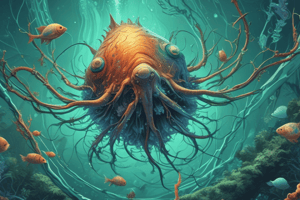Podcast
Questions and Answers
What is the primary role of the counter current mechanism in the nephron?
What is the primary role of the counter current mechanism in the nephron?
- To maintain a concentration gradient in the medullary interstitium (correct)
- To prevent the reabsorption of urea
- To facilitate the passive diffusion of ions
- To enhance the secretion of NaCl in the ascending limb
Which structure directly supports the concentration of urine by allowing NaCl to enter the interstitium?
Which structure directly supports the concentration of urine by allowing NaCl to enter the interstitium?
- Ascending limb of Henle’s loop (correct)
- Collecting tubule
- Vasa recta
- Descending limb of Henle’s loop
How does ADH influence kidney function?
How does ADH influence kidney function?
- By inhibiting water reabsorption in the collecting duct
- By increasing the filtrate production rate in glomeruli
- By enhancing water reabsorption in the latter parts of the nephron (correct)
- By promoting the secretion of electrolytes into the urine
What factor contributes primarily to the increasing osmolarity in the inner medulla?
What factor contributes primarily to the increasing osmolarity in the inner medulla?
Which of the following statements about the vasa recta is true?
Which of the following statements about the vasa recta is true?
What is the primary role of the JGA when there is a fall in glomerular blood flow?
What is the primary role of the JGA when there is a fall in glomerular blood flow?
How does Atrial Natriuretic Factor (ANF) counteract the effects of the renin-angiotensin mechanism?
How does Atrial Natriuretic Factor (ANF) counteract the effects of the renin-angiotensin mechanism?
What triggers the micturition reflex to initiate urination?
What triggers the micturition reflex to initiate urination?
Which of the following accurately describes a characteristic of normal urine?
Which of the following accurately describes a characteristic of normal urine?
What impact does Angiotensin II have on the kidneys?
What impact does Angiotensin II have on the kidneys?
Flashcards are hidden until you start studying
Study Notes
The Countercurrent Mechanism
- The Henle's loop and vasa recta work together to create a concentrated urine.
- Filtrate flows in opposite directions in the two limbs of Henle's loop, forming a countercurrent.
- Blood flow through the vasa recta is also countercurrent.
- This arrangement helps maintain an increasing osmolarity towards the inner medullary interstitium (from 300 mOsmolL–1 in the cortex to about 1200 mOsmolL–1 in the inner medulla).
- NaCl and urea create the osmolarity gradient.
- NaCl is transported by the ascending limb of Henle's loop and exchanged with the descending limb of vasa recta.
- NaCl is returned to the interstitium by the ascending portion of vasa recta.
- Small amounts of urea enter the thin segment of the ascending limb of Henle's loop and are transported back to the interstitium by the collecting tubule.
- This mechanism helps maintain a concentration gradient in the medullary interstitium.
- The gradient facilitates water passage from the collecting tubule, concentrating the filtrate (urine).
- Human kidneys can produce urine nearly four times concentrated than the initial filtrate.
Regulation of Kidney Function
- Kidney function is regulated by hormonal feedback mechanisms involving the hypothalamus, JGA, and heart.
- Osmoreceptors in the body are activated by changes in blood volume, body fluid volume, and ionic concentration.
- Excessive fluid loss activates osmoreceptors, stimulating the hypothalamus to release antidiuretic hormone (ADH) or vasopressin from the neurohypophysis.
- ADH facilitates water reabsorption from the latter parts of the tubule, preventing diuresis.
- Increased body fluid volume suppresses ADH release.
- ADH also constricts blood vessels, increasing blood pressure.
- Increased blood pressure increases glomerular blood flow and GFR.
- The JGA plays a complex regulatory role.
- A fall in glomerular blood flow/glomerular blood pressure/GFR activates JG cells to release renin.
- Renin converts angiotensinogen in blood to angiotensin I, then to angiotensin II.
- Angiotensin II is a powerful vasoconstrictor that increases glomerular blood pressure and GFR.
- Angiotensin II also activates the adrenal cortex to release aldosterone.
- Aldosterone causes reabsorption of Na+ and water from the distal parts of the tubule, increasing blood pressure and GFR.
- This mechanism is known as the Renin-Angiotensin mechanism.
- Increased blood flow to the atria of the heart causes the release of Atrial Natriuretic Factor (ANF).
- ANF causes vasodilation, decreasing blood pressure.
- The ANF mechanism acts as a check on the renin-angiotensin mechanism.
Urine Formation and Excretion
- Urine formed by the nephrons is carried to the urinary bladder for storage.
- The urinary bladder stretches as it fills with urine, activating stretch receptors.
- Stretch receptors send signals to the CNS, which initiates contraction of the bladder's smooth muscles and relaxation of the urethral sphincter, causing urine release.
- This process is called micturition and is controlled by the micturition reflex.
- An adult human excretes, on average, 1 to 1.5 liters of urine per day.
- Urine is a light yellow colored watery fluid, slightly acidic (pH-6.0), with a characteristic odor.
- 25-30 gm of urea is excreted per day.
- Urine analysis can help diagnose metabolic disorders and kidney malfunction.
- For example, glucose (Glycosuria) and ketone bodies (Ketonuria) in urine are indicative of diabetes.
Studying That Suits You
Use AI to generate personalized quizzes and flashcards to suit your learning preferences.




